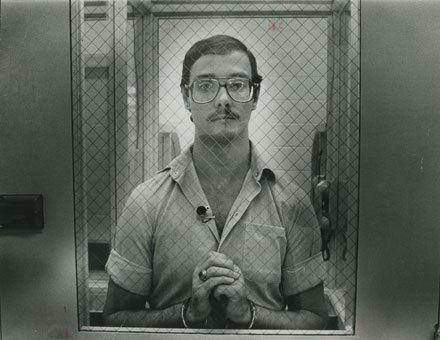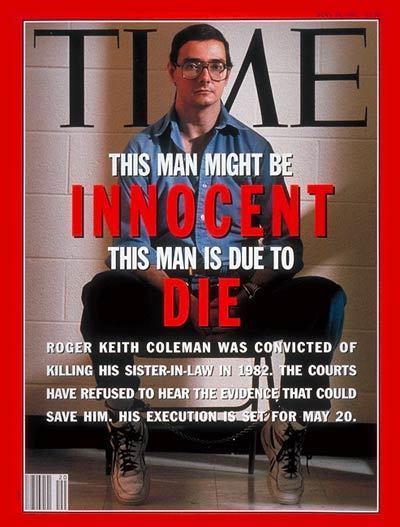Name Roger Coleman | ||
 | ||
Died May 20, 1992, Jarratt, Virginia, United States | ||
Sabrina squire reports on the execution of roger keith coleman nbc12 richmond va
Roger Keith Coleman (November 1, 1958 – May 20, 1992) was a Grundy, Virginia, coal miner who was convicted and executed for the rape and murder in March 1981 of his sister-in-law, Wanda McCoy. That day he had been laid off from work.
Contents
- Sabrina squire reports on the execution of roger keith coleman nbc12 richmond va
- Episode 4 Roger Keith Coleman Conclusion
- Crime
- Case
- State appeals
- Federal petition for habeas corpus
- Controversy and execution
- DNA testing post execution
- Significance for the anti death penalty movement
- References
Coleman's case drew national and worldwide attention before and after his execution because of his repeated claims of innocence. Appeals were supported by the anti death-penalty movement. After his death, his was the second case nationally in which DNA evidence was analyzed of an executed man. In January 2006, Virginia Governor Mark Warner announced that testing of DNA evidence had conclusively proven that Coleman was guilty of the crime.

Episode 4: Roger Keith Coleman Conclusion
Crime

Nineteen-year-old Wanda McCoy was attacked in her home in Grundy, Virginia, on March 10, 1981. She was raped, stabbed to death, and nearly beheaded from severe neck wounds. As there was little sign of a struggle, police believed that she had allowed her attacker into the house.

Her sister's husband Roger Coleman had access to the house and was quickly considered a suspect; he had previously been convicted of attempted rape. Coleman, who worked in a coal mine, had reported to work that night but left after he was laid off.
Physical evidence at the McCoy house included a fingerprint on the front screen door, a pry mark on the front door molding, and bloodstains inside the house. The victim had broken fingernails, cuts on her hands, and a dark, dusty substance on her body. Flecks of blood found on Coleman's pants were determined to be the same blood type as the victim's. At that time, DNA testing was not available.
Case
At a jury trial in 1982, Coleman was convicted of rape and first-degree murder of McCoy.
The prosecution for the case, led by Commonwealth Attorney Michael McGlothlin, asserted:
Coleman's defense maintained:
State appeals
Coleman's initial appeal in 1983 to the Virginia Supreme Court was denied, and the United States Supreme Court denied certiorari. Coleman filed a petition for a writ of habeas corpus in the Circuit Court for Buchanan County, Virginia, raising several federal constitutional claims for the first time. A two-day evidentiary hearing was held, and the court denied all of Coleman's claims. On September 4, 1986, the court entered its final judgment.
Coleman appealed to the Virginia Supreme Court, but this appeal was dismissed on the motion of the Commonwealth because his notice of appeal was not filed in time. The Virginia Supreme Court requires that a notice of appeal be filed within 30 days of entry of the final judgment; Coleman's notice of appeal was filed on October 7, which was 33 days after the circuit court entered its judgment.
Federal petition for habeas corpus
Coleman petitioned in the United States District Court for the Western District of Virginia for a writ of habeas corpus. However, federal courts generally may not review a state court's denial of a federal constitutional claim if the denial is based on a state procedural default that is independent of the federal claim and is sufficient to support the prisoner's continued custody. Since Coleman was in procedural default of his appeal in state court, this was independent of his federal constitutional claims. It was considered adequate to support his continued custody, and he was ineligible for relief in a federal habeas corpus proceeding. Although finding that Coleman was in procedural default, the District Court addressed all of his claims, finding them without merit. The United States Court of Appeals for the Fourth Circuit affirmed the District Court's ruling, as did the US Supreme Court in 1991.
Controversy and execution
In 1990, Coleman's DNA was tested. He was found to be within the 2% of the population who could have committed the crime. Some argued that DNA and blood tests combined reduced this figure to 0.2%.
While he was on death row, Coleman continued to claim his innocence. Given increasing concerns about application of the death penalty in the United States, an international audience became interested in his case. Time magazine featured Coleman on its May 18, 1992, cover. Virginia Governor Douglas Wilder received 13,000 calls and letters about Coleman from around the world, nearly all in favor of clemency. Wilder arranged a secret, last-minute polygraph test for Coleman, who failed.
Coleman was executed May 20, 1992, in the electric chair. He shared his final meal with James McCloskey, executive director of Centurion Ministries, a group that had been working to prove Coleman's innocence. Coleman's final words were,
"An innocent man is going to be murdered tonight. When my innocence is proven, I hope America will realize the injustice of the death penalty as all other civilized countries have. My last words are to the woman I love. Love is eternal. My love for you will last forever. I love you, Sharon." (Sharon Paul was a college student and the girlfriend of Coleman whom he met by mail during prison.)
In 1998, Chicago lawyer John C. Tucker published May God Have Mercy (ISBN 0-385-33294-7), detailing efforts to save Coleman from the death penalty.
DNA testing post-execution
Centurion Ministries and four newspapers, including the Washington Post, sought to have DNA evidence from the case re-examined in 2000. That year was the first instance of a court ordering DNA testing of a man executed for rape and murder: Ellis Wayne Felker in Georgia. The results were inconclusive.
In 2002, the Supreme Court of Virginia declined the request. Centurion Ministries subsequently appealed to Virginia Governor Mark Warner.
On January 5, 2006, Warner ordered retesting of Coleman's DNA evidence. The evidence was sent to the Centre of Forensic Sciences in Toronto, Canada. It determined that his DNA matched that of semen found at the crime scene, with no exclusions, and that there was only a 1-in-19-million chance of a random match. On January 12, 2006, Warner's office announced that the test results conclusively confirmed Coleman's guilt.
Significance for the anti-death penalty movement
Coleman's case was the second instance in the United States in which DNA evidence was examined after the person in question had been executed. The first was in 2000 in Georgia, and the results were for Ellis Wayne Felker were inconclusive.
Supporters who believed Coleman's innocence had expected DNA tests to exonerate Coleman; they were profoundly disappointed. Some death penalty opponents had believed that evidence of an innocent man's execution would have a profound impact on the death penalty debate in the United States, where numerous people on death row had been exonerated. If Coleman had been proven innocent, it would have contributed to anti-death penalty support. Death penalty supporters argued that Coleman's case showed that the criminal justice system was functioning in having guilty people convicted and executed.
